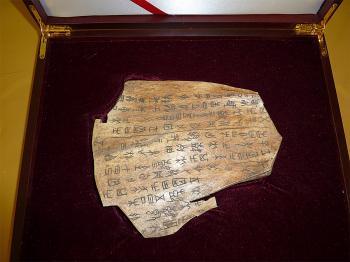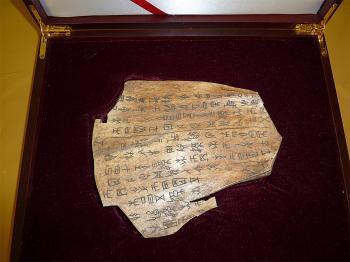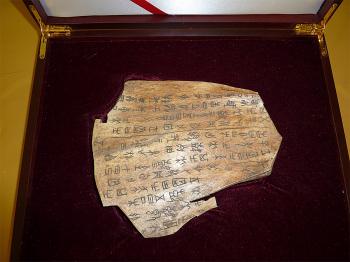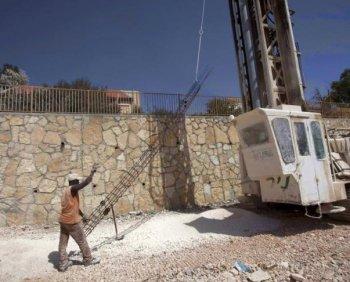HOCKESSIN, Del.—In addition to a wide range of cultural performances and demonstrations, the Chinese American Community Center (CACC) hosted the “Oracle Bones” exhibit at its annual Chinese festival.
According to event organizers, the “Oracle Bones” exhibit is unique in the United States. The exhibit and festival took place June 18–20.
Oracle bones were widely used during the Shang Dynasty (1766–1050 B.C.) as part of a divination process to make important decisions. A king or a high-ranking person would give a question to a diviner.
The diviner would read both a positive or negative question about an important issue, such as warfare or picking an auspicious day for a ceremony.
The diviner would then apply a hot rod to pits already bored into an ox shoulder bone or a turtle shell and observe the way the shell or bone cracked. From this, the diviner would interpret the future.
Later, the questions, the prediction, and the eventual outcomes would be inscribed on the bones or shells. Most importantly, the characters on the oracle bones are the oldest examples of the written Chinese language found to date, some as old as 3,700 years.
At the center of the “Oracle Bones” exhibit were 10 high-quality replicas of original oracle bones housed at the Yinxu Museum at Anyang, Henan Province. According to event organizers, the museum displays the same type of replicas.
The originals have been carefully preserved and kept safe from damage. The replicas at the CACC exhibit, like those at the Yinxu Museum, were created from real ox bones and turtle shells by experts.
“Civilization relies on written language,” said Mr. Kang Lin, chairman of the CACC. Lin, a retired chemical engineer, also said, “When I saw the bones, I felt a deep connection.”
The chairman’s father, a mathematician, was a friend of Zubin Dong (1895–1963), the Chinese archeologist who in the 1920s and 1930s headed the excavations of thousands of oracle bones at Shang Dynasty ruins in Henan Province.
Lin said that approximately 4,000 characters have been identified, and 1,200 have been deciphered. The writings give great detail about major events during the Shang Dynasty.
Unlike Western phonetic alphabets, the Chinese language is a series of characters, each with a different meaning, which in combinations can convey great subtlety and depth. The characters on the oracle bones are simpler than the characters the Chinese language later evolved into.
For instance, the Shang Dynasty-era character for cooperation was three arms parallel to one another, in the exact same pose.
Cindy Wang, a CACC volunteer and spokesperson for the festival, said, “The oracle bones symbolize the ancient people’s respect for the heavens.”
The “Oracle Bones” exhibit also consisted of a documentary about the excavations at Anyang, numerous placards explaining aspects of the oracle bones and the ancient Chinese characters, and a group of volunteers who answered questions.
According to event organizers, the “Oracle Bones” exhibit is unique in the United States. The exhibit and festival took place June 18–20.
Oracle bones were widely used during the Shang Dynasty (1766–1050 B.C.) as part of a divination process to make important decisions. A king or a high-ranking person would give a question to a diviner.
The diviner would read both a positive or negative question about an important issue, such as warfare or picking an auspicious day for a ceremony.
The diviner would then apply a hot rod to pits already bored into an ox shoulder bone or a turtle shell and observe the way the shell or bone cracked. From this, the diviner would interpret the future.
Later, the questions, the prediction, and the eventual outcomes would be inscribed on the bones or shells. Most importantly, the characters on the oracle bones are the oldest examples of the written Chinese language found to date, some as old as 3,700 years.
At the center of the “Oracle Bones” exhibit were 10 high-quality replicas of original oracle bones housed at the Yinxu Museum at Anyang, Henan Province. According to event organizers, the museum displays the same type of replicas.
The originals have been carefully preserved and kept safe from damage. The replicas at the CACC exhibit, like those at the Yinxu Museum, were created from real ox bones and turtle shells by experts.
‘A Deep Connection’
“Civilization relies on written language,” said Mr. Kang Lin, chairman of the CACC. Lin, a retired chemical engineer, also said, “When I saw the bones, I felt a deep connection.”
The chairman’s father, a mathematician, was a friend of Zubin Dong (1895–1963), the Chinese archeologist who in the 1920s and 1930s headed the excavations of thousands of oracle bones at Shang Dynasty ruins in Henan Province.
Lin said that approximately 4,000 characters have been identified, and 1,200 have been deciphered. The writings give great detail about major events during the Shang Dynasty.
Unlike Western phonetic alphabets, the Chinese language is a series of characters, each with a different meaning, which in combinations can convey great subtlety and depth. The characters on the oracle bones are simpler than the characters the Chinese language later evolved into.
For instance, the Shang Dynasty-era character for cooperation was three arms parallel to one another, in the exact same pose.
Symbolic Meaning
Cindy Wang, a CACC volunteer and spokesperson for the festival, said, “The oracle bones symbolize the ancient people’s respect for the heavens.”
The “Oracle Bones” exhibit also consisted of a documentary about the excavations at Anyang, numerous placards explaining aspects of the oracle bones and the ancient Chinese characters, and a group of volunteers who answered questions.




